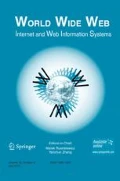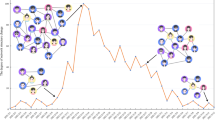Abstract
How can we discover and estimate major events in complex social networks? Even with ever enlarging networks and data scale? Event detection and evaluation in social networks provide an effective solution, which has become the critical basis for many real applications, such as crisis management and decision making. The existing event detection methods mainly focus on text analysis that is limited in social media content and graphic feature statistic that needs calculate vast variables. Can we find an efficient way for generalized social networks with limited topology information? In this paper, a novel hybrid quantum swarm intelligence indexing method (HQSII) from the perspective of link prediction is proposed for the first time, which includes an optimal weight algorithm (OWA) and a fluctuation detection algorithm (FDA). The innovations behind HQSII lie in three aspects: (1) The mixed index that can universally describe the social network evolutions is proposed firstly, which explores the cooperation of different independent similarity indexes. OWA is further proposed to determine the optimal mixed index that achieves higher link prediction accuracy and better network evolution description than other independent and mixed similarity indexes. (2) To better avoid the interferences of routine network evolution fluctuations, the otherness of micro node evolutions is considered into link prediction. FDA is further proposed to quantify the abnormal fluctuations caused by events. (3) Based on OWA and FDA, HQSII is proposed for all the generalized social networks, which detects events by discovering abnormal fluctuations and evaluates events by analyzing fluctuation trends. Extensive experiments on theoretical and real-world social networks show that HQSII can accurately detect events and quantitatively evaluate event impacts in social networks with single and multiple events.






Similar content being viewed by others
References
Adamic L.A., Adar E.: Friends and neighbors on the Web[J]. Soc. Networks. 211–230 (2003)
Akoglu L., Tong H., Koutra D.: Graph based anomaly detection and description: a survey. Data Min. Knowl. Disc. 29, 626–688 (2015)
Barabasi A.A.R.: Emergence of scaling in random networks. Science. 286, 509–512 (1999)
Barabási A.L., Albert R.: Emergence of scaling in random networks. Science. 286, 509–512 (1999)
Cannistraci C.V., Alanis-Lobato G., Ravasi T.: From link-prediction in brain connectomes and protein interactomes to the local-community-paradigm in complex networks. Sci. Rep. 3(4), 1613–1613 (2013)
Chen B., Chen L.: A link prediction algorithm based on ant colony optimization. Appl. Intell. 41(3), 694–708 (2014)
Chen B., Chen L., Li B.A.: Fast algorithm for predicting links to nodes of interest. Inf. Sci. 329, 552–567 (2016)
Cho Y., Honorati M.: Entrepreneurship programs in developing countries: a meta regression analysis. Gen. Inform. 110–130 (2014)
Cui Y., Pei J., Tang G., Luk W.S., Jiang D., Hua M.: Finding email correspondents in online social networks. World Wide Web-internet & Web Inf. Syst. 16(2), 195–218 (2013)
Dong X., Mavroeidis D., Calabrese F., Frossard P.: Multiscale event detection in social media. Data Min. Knowl. Disc. 29, 1374–1405 (2014)
Ekeberg M., Hartonen T., Aurell E.: Fast pseudolikelihood maximization for direct-coupling analysis of protein structure from many homologous amino-acid sequences. J. Comput. Phys. 276, 341–356 (2014)
Gesek, G.: Quantum information theory. World Wide Web-internet & Web Information Systems (2012)
Hanley J.A., Mcneil B.J.: The meaning and use of the area under a receiver operating chracteristic (roc) curve. Radiology. 143, 29–36 (1982)
Herlocker J.L., Konstan J.A., Terveen L.G., Riedl J.T.: Evaluating collaborative filtering recommender systems. ACM Trans. Inf. Syst. 22, 5–53 (2004)
Hu Z., Bao Y., Xiong T.: Comprehensive learning particle swarm optimization based memetic algorithm for model selection in short-term load forecasting using support vector regression. Appl. Soft Comput. 25, 15–25 (2014)
Hu, W.B., Peng, C., Liang, H.L., Du, B.: Event detection method based on link prediction for social network evolution. J. Softw. (2015)
Iglesias F., Zseby T.: Analysis of network traffic features for anomaly detection. Mach. Learn. 101, 59–84 (2014)
Jaccard P.: Etude comparative de la distribution florale dans une portion des Alpes et du Jura[M]. Impr. Corbaz. 37, 547 (1901)
Jamali, M., and Abolhassani, H.: Different aspects of social network analysis. IEEE. 66–67 (2006)
Kleinberg, Liben Nowell J.: The link-prediction problem for social networks. Am. Soc. Inf. Sci. Technol. 58(7), 1019–1031 (2003)
Leicht E.A., Holme P., Newman M.E.J.: Vertex similarity in networks. Phys. Rev. E. 73, 026120 (2012)
Li Y., Jiao L., Shang R., Stolkin R.: Dynamic-context cooperative quantum-behaved particle swarm optimization based on multilevel thresholding applied to medical image segmentation. Inf. Sci. 294, 408–422 (2015)
Lin Y.R., Chi Y., Zhu S., Sundaram H., Tseng B.L.: Analyzing communities and their evolutions in dynamic social networks. ACM Trans. Knowl. Discov. Data. 3(2), 307–308 (2009)
Liu H.K., Lü L.Y., Zhou T.: Uncovering the network evolution mechanism by link prediction. Sci. Sin Phys. Mech. Astron. 41, 816–823 (2011)
Liu J., Teo K.L., Wang X., Wu C.: An exact penalty function-based differential search algorithm for constrained global optimization. Soft. Comput. 20, 1305 (2015)
Lü L., Zhou T.: Link prediction in complex networks: a survey. Physica A Stat. Mech. Appl. 390, 1150–1170 (2011)
Mcculloh I.A., Carley K.M.: Social network change detection. Carnegie Mellon University School of Computer Science Institute for Software Research (2010)
Musiał K., Kazienko P.: Social networks on the internet. World Wide Web-internet & Web Inf. Syst. 16(1), 31–72 (2012)
Papadimitriou P., Dasdan A., Garcia-Molina H.: Web graph similarity for anomaly detection. J. Internet Serv. Appl. 1, 19–30 (2010)
Pobiedina N., Ichise R.: Citation count prediction as a link prediction problem. Appl. Intell. 44, 252 (2014)
Priebe C.E., Conroy J.M., Marchette D.J., Park Y.: Scan statistics on enron graphs. Comput. Math. Organ. Theory. 11(3), 229–247 (2005)
Qian-Ming Z., Linyuan L., Wen-Qiang W., Tao Z.: Potential theory for directed networks. PLoS One. 2013, (2013)
Rapoport A., Rapoport A.: Spread of information through a population with socio-structural bias. Bull. Math. Biophys. 15, 523 (1953)
Ravasz E., Somera A.L., Mongru D.A.: Hierarchical organization of modularity in metabolic networks. Science. 297, 1551–1555 (2002)
Salton, G., McGill, M.H.: Introduction to modern information retrieval. Computerlinguistik McGraw-Hill, Inc. (1998)
Serrà J., Arcos J.L.: Particle swarm optimization for time series motif discovery. Knowl.-Based Syst. 92, 127–137 (2015)
Shi Y., Liu H., Gao L., Zhang G.: Cellular particle swarm optimization. Inf. Sci. 181, 4460–4493 (2011)
Sørensen T.: A method of establishing groups of equal amplitude in plant sociology based on similarity of species and its application to analyses of the vegetation on Danish commons. Biol. Skr. 1–34, (1948)
Stilo G., Velardi P.: Efficient temporal mining of micro-blog texts and its application to event discovery. Data Min. Knowl. Disc. 30, 372–402 (2015)
Unankard S., Li X., Sharaf M.A.: Emerging event detection in social networks with location sensitivity. World Wide Web-internet & Web Inf. Syst. 18(5), 1–25 (2014)
Wan, X., Milios, E., Kalyaniwalla, N., and Janssen, J. (2009) Link-based event detection in email communication networks. Sac Proceedings of the Acm Symposium on Applied Computing
Wang Y., Meyer J.W., Ashraf M., Shull G.E.: A new genetic algorithm for release-time aware divisible-load scheduling. Circ. Res. 93(8), 776–782 (2014)
Washio T., Motoda H.: State of the art of graph-based data mining. Acm Sigkdd Explor. Newsl. Homepage. 15(1), 59–68 (2003)
Watts D.J., Strogatz S.H.: Collective dynamics of ‘small-world’ networks. Nature. 393(6684), 440–442 (1998)
Yan Y., Yang Y., Meng D., Liu G., Tong W., Hauptmann A.G.: Event oriented dictionary learning for complex event detection. IEEE Trans. Image Process. 1867–1878 (2015)
Yu H., Kim S.K., Kim J.: Scalable and parallelizable processing of influence maximization for large-scale social networks? 2014 I.E. 30th international conference on data. Engineering. 266–277 (2014)
Zhang Q.M., Xu X.K., Zhu Y.X., Zhou T.: Measuring multiple evolution mechanisms of complex networks. Eprint Arxiv. 2014, (2014)
Zhou X., Chen L.: Event detection over twitter social media streams. VLDB J. 23(3), 381–400 (2014)
Zhou T., Ren J., Medo M.: Bipartite network projection and personal recommendation. Phys. Rev. E Stat. Nonlinear Soft Matter Phys. 70–80 (2007)
Acknowledgments
This work is supported by the National Natural Science Foundation, China (No.61572369, 70901060 and 61471274), the Hubei Province Natural Science Foundation (No. 2014CFB193 and 2015CFB423), the State Key Lab of Software Engineering Open Foundation (No. SKLSE 2010-08-15), the Youth Plan Found of Wuhan City (No.2011-50431101). And the authors also gratefully acknowledge all reviewers, and their comments have improved the presentation.
Author information
Authors and Affiliations
Corresponding authors
Rights and permissions
About this article
Cite this article
Hu, W., Wang, H., Qiu, Z. et al. An event detection method for social networks based on hybrid link prediction and quantum swarm intelligent. World Wide Web 20, 775–795 (2017). https://doi.org/10.1007/s11280-016-0416-y
Received:
Revised:
Accepted:
Published:
Issue Date:
DOI: https://doi.org/10.1007/s11280-016-0416-y




